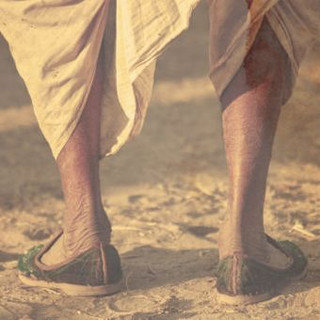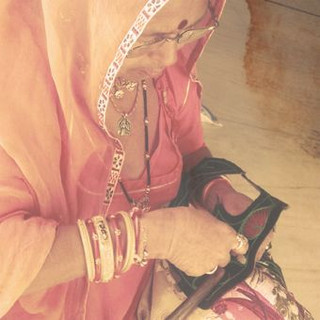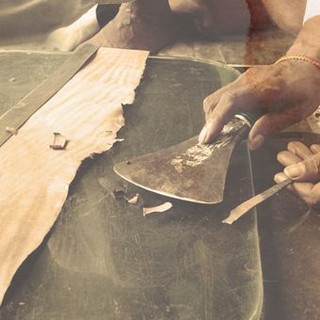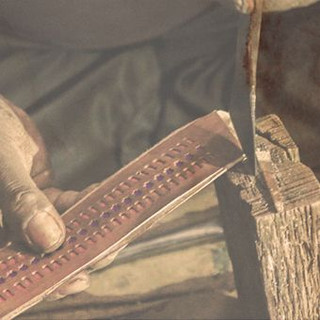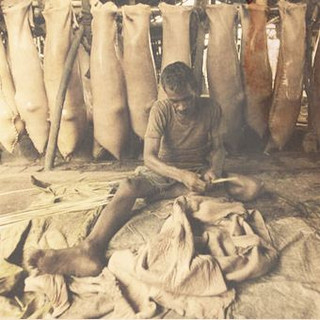


CHAPTER I . HARD MATERIALS
Leather Work
In Rajasthan ...
In Kutch, Gujarat...
THE RECYCLING ORIGINS
In Kutch (Gujarat, India) Leather Work was earlier on a partnership between the Maldharis (nomadic pastoralist) experts in tanning, and the Dalit Meghwals (leather, stitching and embroidery craftsmen) migrants from Rajasthan.
The tradition was a recycling process: when a Maldhari cattle would die, the Meghwals would convert the raw hides into leather, on an intensive labour of approximately 18 days, and then into a product of utility - giving life to waste.
The Leather Work was traditionally used to make harnesses for camels and horses, musical instruments, storage containers and footwear, once the local leather was very good, durable and even resistant to water.
In our days, Kutch Leather Work is a means of business and livelihood for many villages in the region.
NOW
Due to the arising of cheaper factory-made products in the markets, the craft and the community linkages started to break up.
Meghwals are no longer converting raw hide into leather because of social stigmas, therefore, leather artisans are now dependent on external markets.
Many artisans are opting to work in factories, leaving their traditional leather craft. Local leather craft is losing its quality, adopting a cheap aesthetic that satisfies regional tourism.
For many communities and villages in Kutch, this craft is still an important supplement to the income from farming.
THE PROCESS
The main Leather Work techniques in Kutch are Jari Kaam, which uses a silver and golden Jari (stitch) for different decorations, and Torni, where the coarse yarns are used to create colorful patterns.
Traditionally Jari Kaam was used to decorate horse back riding gear, and now we can find the same style in modern products like shoes, bags, etc.
The Torni technique it's mainly used to decorate the borders of leather goods.
The craftsmen either leave the leather in its natural colour or dye it with strainers in shades or brown, and sometimes even bright colours like yellows, blues and reds. This leather dyeing practice is unique to Kutch.
Decorations can be made using punches of a range of shapes and sizes: the craftsmen make holes in the leather for a reverse appliqué like technique. ; placing patterned and block printed Kutchi fabrics pieces in bright hues under the punched holes in leather.
The pieces of leather are hand stitched by passing thick thread through small slits made with a stitching awl. Craftsmen have also started using sewing machines to assemble the pieces together, thereby adding efficiency to the traditional craft.
Men are responsible for all the cutting, punching, shaping and joining the leather pieces; women add the necessary colourful embellishment to the leather with their embroidery skills.
LEATHER WORK IN RAJASTHAN & KUTCH
Shop
THE MOCHIS & JUTTIS
The shoemakers’ community in Rajasthan (India) is known as Mochi - the Mochi are cobblers and saddlers. The Chamars, who are tanners, do the initial preparation of make leather from raw hides, while Mochis use the finished leather to make shoes, boots and handbags.
The Mochi also claim that they are descended from the Rajputs or Brahmins in order to give their caste a better standing in religious and social hierarchy.
Legend says that god Brahma’s son used to sacrifice cows to the gods, eat a portion of the sacrifice, then restore the offering back to life and drive it into the forest. Then one day he failed to resurrect the cow because his pregnant wife had secretly stolen a portion. This resulted in a curse and she gave birth to the first Mochi.
The Juttis are a kind of footwear traditional in Rajasthan made from locally cured leather. They are very well known for the quality of workmanship and the variety and richness of design. They are entirely handcrafted and are measured with the fingers!
There is no difference between the right and the left foot once the Jutti takes very easily the shape of the wearer's foot.
PROCESS
First, the Chamars (tanners), do the preparation of make leather from raw hides (camel, buffalo, goat). When the leather is finished the Mochi start to create different layers of a sole stuck with homemade glue, once this is dry, the sole is stitched with cotton or leather thread.
Women use theirs embroidery skills to decorate the upper portion of the Jutti. Plain or coloured piping is stitched to the edge of the inside portion of the upper form after the leather is dipped in water to make it soft. At every stage the leather is hammered to make the stitching and the pasting firm.
When the upper form has been attached to the sole it is put on a wooden last to give it a final shape.
The tools used in this process are simple: a needle, a knife, a wooden block, and a hammer.
GOOD TO KNOW
Mano Etna products

100%
handmade
sustainable materials
preferred



